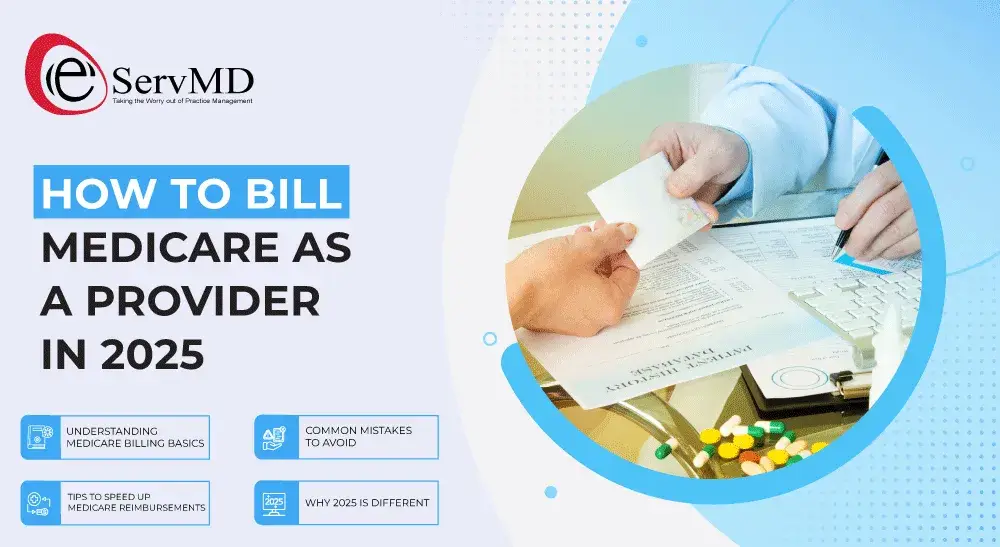
Billing Medicare correctly has always been a challenge for doctors, clinics, and healthcare organizations. In 2025, with new CMS policies, increased automation, and growing compliance requirements, knowing how to bill Medicare as a provider in 2025 is more important than ever. Done right, it means fewer claim denials, faster reimbursements, and a more stable cash flow for your practice. Done wrong, and you face delayed payments, compliance risks, and even financial penalties.
This step-by-step guide will help providers understand the Medicare billing process, avoid common mistakes, and use proven strategies to speed up reimbursements.
Understanding Medicare Billing Basics
Before learning the Medicare billing step-by-step guide, it’s important to know the basics.
Who can bill Medicare?
Any provider who is properly enrolled and credentialed can bill Medicare, including physicians, nurse practitioners, physician assistants, and certain specialists.
Medicare Parts and Billing Differences:
-
Part A: Covers hospital stays and inpatient services.
-
Part B: Covers outpatient visits, diagnostics, preventive care.
-
Part C (Medicare Advantage): Managed by private insurers with unique billing rules.
-
Part D: Prescription drug coverage.
Each part has unique requirements, making it essential for providers to stay updated on the Medicare billing requirements for providers.
👉 Learn more about our Medical Billing Services to simplify your practice workflow.
Step-by-Step Guide: How Providers Submit Medicare Claims
Billing Medicare is not just about submitting a claim it’s about following a structured process. Here’s the step-by-step Medicare billing process for doctors:
Step 1: Provider Enrollment and Credentialing
Before submitting claims, you must complete Medicare provider enrollment and billing credentialing. Without proper credentialing, Medicare will not reimburse your services.
📌 Related Service: Provider Credentialing
Step 2: Patient Eligibility Verification
Always verify patient eligibility before providing care. Missing this step is one of the leading causes of Medicare claim denials.
📌 Related Service: Eligibility & Authorization Services
Step 3: Accurate Medical Coding & Documentation
Using correct codes and modifiers is critical to avoid Medicare billing mistakes. Errors here directly delay payments.
📌 Related Service: Medical Coding Services
Step 4: Submitting Claims (Paper vs. Electronic)
While Medicare still accepts paper claims, electronic submissions are faster, more accurate, and reduce rejections. Many providers prefer billing Medicare electronically as a provider for speed.
Step 5: Tracking, Follow-ups, and Appeals
Billing doesn’t end at submission. Providers must track claims, follow up on pending payments, and appeal denied claims. This is where outsourced medical billing services save time and reduce errors.
Common Medicare Billing Mistakes to Avoid
Mistakes in Medicare billing cost providers thousands each year. Here are the biggest pitfalls:
-
Skipping eligibility checks
-
Incorrect coding or modifiers
-
Late claim submissions
-
Not appealing denied claims
👉 If your practice struggles with these, Revenue Cycle Management Services can help reduce claim denials and optimize collections.
Tips to Speed Up Medicare Reimbursements
Faster reimbursements mean stronger financial health for providers. Here’s how to achieve it in 2025:
-
Use EHR-integrated billing systems – They cut down on manual errors.
-
Train staff regularly – Medicare updates rules frequently.
-
Outsource to experts – Partnering with a medical billing company ensures compliance and reduces administrative burden.
📌 See our Practice Management Consulting solutions for complete support.
Why 2025 Is Different: Latest Trends in Medicare Billing
Medicare billing in 2025 is not the same as it was a few years ago. Here’s what’s new:
-
CMS policy updates have added new compliance checks.
-
AI and automation are now being used for real-time eligibility checks and claim scrubbing.
-
The focus is on reducing billing errors in medical practice to improve overall reimbursement efficiency.
👉 Considering a new clinic? Check our New Practice Setup Services.
Related Resources for Providers
Conclusion: Better Billing = Better Revenue
Correct Medicare billing process for doctors is not just about compliance it’s about ensuring your practice gets paid on time, every time. By avoiding common mistakes, using automation, and considering outsourced billing solutions, providers can achieve faster Medicare reimbursements in 2025.
📌 Ready to simplify billing and improve your revenue cycle? Schedule a Demo with eServMD today and see how our experts can optimize your medical billing services for private practice.
FAQs — How to bill Medicare as a provider
1. How do I bill Medicare as a provider in 2025?
To bill Medicare as a provider in 2025, start with proper credentialing, verify patient eligibility, use accurate CPT and ICD-10 codes, and submit claims electronically. Following the updated Medicare billing process for doctors ensures faster reimbursements.
2. What are the most common Medicare billing mistakes providers make?
Common errors include skipping eligibility checks, using incorrect modifiers, or missing claim deadlines. These Medicare billing mistakes often lead to payment delays or denials.
3. How can providers speed up Medicare reimbursements in 2025?
Using EHR-integrated systems, AI-driven billing software, and outsourced medical billing services can significantly improve accuracy and reduce reimbursement delays.
4. What are the new Medicare billing requirements for providers in 2025?
In 2025, CMS has implemented stricter documentation and claim validation standards. Providers must follow updated Medicare billing requirements and maintain compliance to avoid penalties.
5. Why should I consider outsourcing my Medicare billing?
Outsourcing to a medical billing company for Medicare helps reduce administrative workload, minimize claim denials, and ensure compliance with CMS guidelines leading to faster and more consistent payments.
